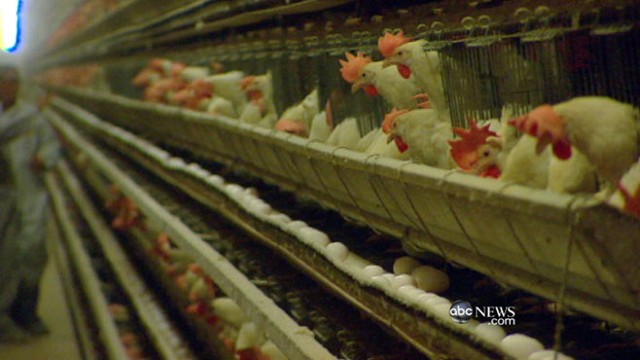If you had asked me 5 years ago that I would be eating a vegan diet, I would have laughed out loud, and bet you a million dollars you would be wrong. And you would be a millionaire now...
Although I've only been vegan for one month, I don't see any way I will go backwards, as I think it's the only diet I can live with now, and not feel guilty.
I'd like to share the process I went through to get to this point, to show you how you can transition, even if you love meat and don't think you can live without it.
What is vegan?
A vegan diet does not require any animals or animal by-products. That includes meat (beef, chicken, lamb, fish, etc), dairy (milk, cheeses, yogurt, cream, etc) or any animal by-product (honey from bees, eggs from chickens and other birds, sugars grounded using animal bones, food coloring and dyes made from insects, etc). If an animal was required anywhere in the food production process, then it is not vegan, and I do not eat it.
 |
| I won't show any gross images, but there are plenty online of what animals go through |
The reason I am choosing this diet is so I can help reduce the animal cruelty that takes place (often behind the scenes) to provide us with these food sources. You can learn more reasons to go vegan at
Bite Size Vegan >>>
My food story (the short version)
When I grew up, I hated fruits and vegetables. I recall only eating bananas on a rare occasion, and nothing else. That was until I went to college. I slowly added a few more fruits and vegetables, like broccoli, watermelon, raspberries and carrots. But I still preferred a meat-based diet.
When I met my wife, she was a really good cook, and started making more meals without meat. Before I realized it, I didn't eat that much meat anymore, and I didn't really mind. As I became more aware of the environmental impact of meat (destroying trees for pasture, emitting methane), I decided to stop eating meat completely, and try to go vegetarian. It was very difficult, since I enjoyed eating meat. But my desire to help the environment kept me motivated.
As it became easier to eat vegetarian (it took about 5 years), the idea of going vegan became more realistic. At first, I never thought I could, because I really like cheese. In fact, I ate at least one meal every day that had melted cheese on it (pizza, burritos, grilled sandwiches and subs, egg and cheese breakfast sandwiches, veggie burgers, etc).
After watching
Bite Size Vegan (Emily Moran Borwick) and Gary Yarouvsky videos (see below), I could no longer ignore what was going on with my food decisions. My wife had been vegan in the past after watching
Meet your Meat videos, but had trouble maintaining it where she lived.
When we moved to Portland, Oregon, we had many more options for vegan food. In fact, I didn't even realize that my wife only made vegan dinners at night since we moved. I realized that all I had to do was adjust my breakfast and lunch routine, and I could actually be vegan. So one year after we moved to Portland, we decided to give it a try.
It's been one month now. I've now figured out vegan options for breakfast and lunch, and managed to get through some business and family trips without a problem, so I am now confident that I can maintain the diet for a long time. I am motivated based on the animal cruelty, and I have the setup and education that makes it easy to keep it going.
Based on what I went through, here is a 12 step "roadmap" for how anyone can transition from heavy meat eater to vegan, without feeling overwhelmed or too frustrated.
Note: Any steps towards becoming vegan (even if you never get there) is better than doing nothing, so give it a try and see how far you can get! In addition, no one is 100% perfect on their diet, so if you have a slip up, or make a mistake, don't beat yourself up. Learn from it, and don't throw all your hard work away just for one minor mistake. If I'm about to starve to death, you can bet I'll eat a juicy steak!
Step 1: Meatless Mondays - Try to choose one day per week where you don't eat any meat. Look for meat alternatives (which I love!) that taste and look like meat, but aren't actually meat. Popular items include veggie or bean burgers, tofu, seitan BBQ, textured vegetable protein (TVP) wings,
vegan jerky, and tempeh bacon. Check your local grocery store or food co-op for these options. I think the meat alternatives were critical for me to become vegan, as it allowed me to still eat the food I love.
Step 2: Meatless Mondays, Wednesdays and Fridays - Simply increase the number of days that you don't eat meat, adding one additional day per week as you feel comfortable.
Step 3: Eliminate beef and lamb - Beef and lamb require a lot of grains and food and water to keep them fed, and they have the largest environmental impact.
If you can simply remove these items from your diet completely, and switch to chicken and fish instead, over time you will not even miss them. Excessive amounts of beef and lamb are not good for your health either, so removing them from your diet does more than just reduce your impact on nature.
Step 4: Go meatless and become a vegetarian! Hopefully you've found some good meat alternatives, and are getting up to 5-6 days per week without meat. Take the last step, and go meatless altogether! This took a very long time for me, so don't rush this step too quickly, or you will likely give up the entire effort. Take your time, and keep looking for alternative meat options, try new food dishes, and check out new restaurants. You will also realize that you will need to plan your meals ahead of time more than you do today, so you aren't caught off guard. The hardest part is social events, family get-togethers and dinner out with friends.
Step 5: Milk-free on Mondays - This is the same as Meatless Mondays. Pick one day where you eliminate dairy, and replace it with dairy alternatives, such as soy milk,
almond milk, or rice milk. This was an easy switch for me, as I like the taste of these milk options.
Step 6: Milk-free and cheese-free on Mondays - Cheese was a more difficult option for me. There are vegan cheese options, such as daiya, cashew soy and nutritional yeast options. I've had the most success by eliminating cheese as much as I can, since even in Portland, vegan cheeses are difficult to find.
Step 7: Vegan Mondays - This was a difficult step, as I didn't realize how many products were vegan, even after reading the ingredients. Many people I talked to at restaurants do not know either. Some bread is vegan, but not all. Most baked goods are not vegan (cookies, brownies, cakes, muffins, etc). Honey is not vegan, but it shows up in a lot of products. Creams, dressings, and many other items are not vegan, so it can be difficult to figure out. I've already made a bunch of mistakes, but every day gets better. Again, if you make a mistake, learn from it, and try not to repeat the mistake next time. Check the restaurant websites, or visit
"Accidentally vegan list of foods" from PETA, or download the
"Is it Vegan?" app to help you out.
Step 8: Go milk-free and cheese-free more than one day per week - Continue to increase the number of days each week where you eliminate cheese and dairy from your diet, and replace with alternatives if necessary.
Step 9: Eliminate milk - Stop drinking milk that comes from cows, and replace with milk alternatives. I was already adding soy milk to my coffee each morning, so that wasn't a very difficult step.
Step 10: Vegan Mondays, Wednesdays and Fridays- Continue to add days to the week that you are vegan, so you start to learn all the foods that are acceptable, and those to avoid or check the ingredients closely.
Step 11: Eliminate cheese - Replace cheese with cheese alternatives. I found that it helped to replace cheese with other sauces on sandwiches, and only eat pizza when I could find vegan cheeses or no cheese frozen pizzas (
Amy's No Cheese Pizza).
Step 12: Go vegan! Now that you are vegan more than a couple days per week, and have replaced milk and cheese, the final step shouldn't be too difficult now.
As a reminder, this process can take years to complete, so don't go to fast and get too frustrated, but make sure you revisit the list often, so you don't lose sight of the ultimate goal. If you stop short of the goal, and only get to vegetarian, or Meatless Mondays, you're still doing something positive!
Does this roadmap seem reasonable? Did you take a different route that worked for you? Does it still seem difficult to accomplish? Let us know in the comments section below...














